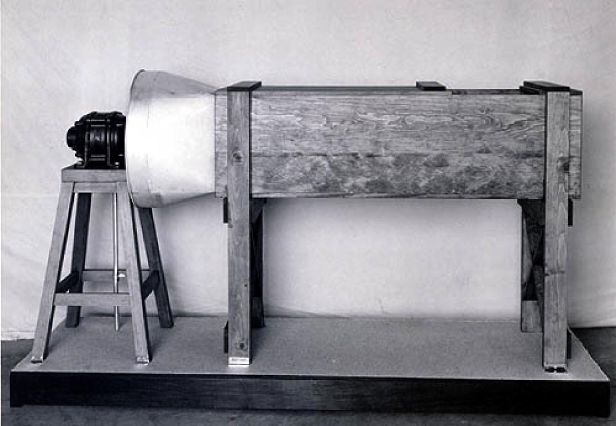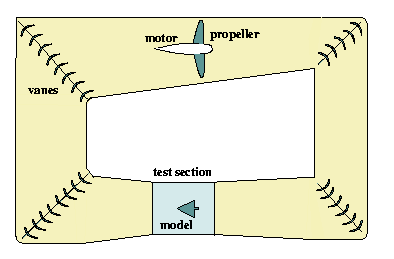Everyone knows about the Wright Brothers' invention of the
first sustained-flight airplane. Few people know, however,
that there was an awful lot of science behind it, and that
the science of flight started with a fan, a couple of
boards, a piece of hacksaw blade and a bicycle spoke. Here, in
the actual words of Wilbur Wright, is a description of the
wind tunnel they built to try out more than 200 models before
they built one and actually tried to fly it. The wind tunnel
they built had an accuracy which rivaled modern wind tunnels.
Wilbur Wright:
"My brother Orville and I built a rectangle-shaped open-ended
wind tunnel out of a wooden box. It was 16 inches wide by 16
inches tall by 6 feet long. Inside of it we placed an
aerodynamic measuring device made from an old hacksaw blade
and bicycle-spoke wire. We directed the air current from an
old fan in the back shop room into the opening of the wooden
box. In fact, we sometimes referred to one of the two open
ends of the wind tunnel as the "goesinta" and the other end
as the "goesouta." An old one-cylinder gasoline engine (that
also turned other tools in the shop, such as our lathe)
supplied the power to turn the fan. This was because there
was no electricity in our shop. In fact, even the lights were
gas lights.
"It took us about a month of experimenting with the wind
tunnel we had built to learn how to use it effectively.
Eventually we learned how to operate it so that it gave us
results that varied less than one-tenth of a degree.
Occasionally I had to yell at my brother to keep him from
moving even just a little in the room because it would
disturb the air flow and destroy the accuracy of the test.
Over a two month period we tested more than two hundred
models of different types of wings. All of the models were
three to nine inches long. Altogether we measured monoplane
wing designs (airplanes with one wing), biplanes, triplanes
and even an aircraft design with one wing behind the other
like Professor Langley proposed. Professor Langley was the
director of the Smithsonian Museum at the time and also
trying to invent the first airplane. On each little aircraft
wing design we tested we located the center of pressure and
made measurements for lift and drift. We also measured the
lift produced by wings of different "aspect ratios." An
aspect ratio is the ratio or comparison of how long a wing
is left to right (the wing span) compared to the length from
the front to the back of the wing (the wing chord). Sometimes
we got results that were just hard to believe, especially
when compared to the earlier aerodynamic lift numbers supplied
by the German Lillienthal. His numbers were being used by most
of the early aviation inventors and they proved to be full of
errors. Lillienthal didn't use a wind tunnel like Orville
and I did to obtain and test our data.
"We finally stopped our wind tunnel experiments just before
Christmas, 1901. We really concluded them rather reluctantly
because we had a bicycle business to run and a lot of work to
do for that as well.
"It is difficult to underestimate the value of that very
laborious work we did over that homemade wind tunnel. It
was, in fact, the first wind tunnel in which small models
of wings were tested and their lifting properties accurately
noted. From all the data that Orville and I accumulated
into tables, an accurate and reliable wing could finally
be built. Even modern wind tunnel data with the most
sophisticated equipment varies comparatively little from
what we first discovered. In fact, the accurate wind tunnel
data we developed was so important, it is doubtful if anyone
would have ever developed a flyable wing without first
developing this data. Sometimes the non-glamorous lab work
is absolutely crucial to the success of a project.
"In any case, as famous as we became for our "Flyer" and its
system of control, it all would never have happened if we
had not developed our own wind tunnel and derived our own
correct aerodynamic data."
|
Wind tunnels today come in many types, from low-speed wind
(for use in designing cars) to those which generate
hypersonic wind speeds (for testing beyond-mach speed planes).
One major development was the "choking down" of the actual
area where the wind passes over the model, in order to make
the wind go faster there. Another major development which
helped is the "closed-return" system which takes the "goesouta"
wind, already moving at top speed, and funnels it back around
to the "goesinta" end for added efficiency. Both these
improvements are shown in the diagram, below:
|


